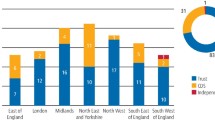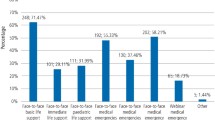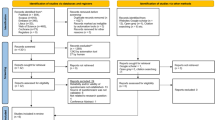Abstract
Objective Attendance at accident and emergency departments (A&E) for non-traumatic dental conditions (NTDC) is increasing in high-income countries. Not all NTDC visits to A&E are inappropriate; however, those that are take up capacity with conditions which are adding to the pressure regarding cost and healthcare utilisation for A&E departments. The scale of this problem is yet to be understood in the United Kingdom (UK). The aim of this study was to systematically review the literature to identify peer-reviewed research publications reporting non-traumatic dental presentations at A&E departments in the UK.
Data sources A structured search of Cochrane Library, EMBASE, MEDLINE, CINAHL, PsycINFO, Scopus and Web of Science databases from their earliest date to May 2018. Hand-searching of identified articles that met the inclusion criteria was also reviewed.
Data selection Publications were included if they were primary research on A&E users in the UK with NTDC as the primary reason for the A&E visit.
Data extraction Data were extracted on the study, patient and visit characteristics.
Data synthesis Studies were assessed for methodological quality and the analysis took the form of a narrative review.
Conclusion There is limited evidence, of variable quality, to inform on the extent of inappropriate presentations of patients with non-urgent NTDC to A&E departments in the UK. The evidence supports the hypothesis that dental patients are inappropriately seeking care for NTDC at A&E departments and this may be a driver of unnecessary antibiotic prescriptions. Further research should focus on the reasons for this occurrence.
This is a preview of subscription content, access via your institution
Access options
Subscribe to this journal
Receive 24 print issues and online access
$259.00 per year
only $10.79 per issue
Buy this article
- Purchase on Springer Link
- Instant access to full article PDF
Prices may be subject to local taxes which are calculated during checkout

Similar content being viewed by others
References
British Dental Association. Toothache piling financial pressure on A&E. January 2017. Available at https://bda.org/news-centre/blog/toothache-piling-the-pressure-on-a-and-e (accessed June 2017).
Anderson R, Richmond S, Thomas D W. Patient presentation at medical practices with dental problems: an analysis of the 1996 General Practice Morbidity Database for Wales. Br Dent J 1999; 186: 297-300.
Verma, S, Chambers I. Dental emergencies presenting to a general hospital emergency department in Hobart, Australia. Aust Dent J 2014; 59: 329-333.
Rastenienė R, Aleksejūnienė J, Pūrienė A. Determinants of Length of Hospitalization due to Acute Odontogenic Maxillofacial Infections: A 2009-2013 Retrospective Analysis. Med Princ Pract 2015; 24: 129-135.
Roberts R M, Hersh A L, Shapiro D J, Fleming-Dutra K E, Hicks L A. Antibiotic Prescriptions Associated With Dental-Related Emergency Department Visits. Ann Emerg Med 2018; DOI: 10.1016/j.annemergmed.2018.09.019.
BDJ. BDA Update. Br Dent J; 2017; 222: 73.
Okunseri C. There are More Than 1.3 Million Emergency Department Visits and Charges of $1 Billion Annually due to Nontraumatic Dental Conditions in the United States. J Evid Based Dent Pract 2015; 15: 33-34.
Figueiredo R, Fournier K, Levin L. Emergency department visits for dental problems not associated with trauma in Alberta, Canada. Int Dent J 2017; 67: 378-383.
Brondani M, Ahmad S H. The 1% of emergency room visits for non-traumatic dental conditions in British Columbia: Misconceptions about the numbers. Can J Public Health 2017; DOI: 10.17269/CJPH.108.5915.
Currie C C, Stone S J, Connolly J, Durham J. Dental pain in the medical emergency department: a cross-sectional study. J Oral Rehabil 2017; 44: 105-111.
Thomson H, Kohli H S, Brookes M. Non-emergency attenders at a district general hospital accident and emergency department. J Accid Emerg Med 1995; 12: 279-281.
Lee H H, Lewis C W, Saltzman B, Starks H. Visiting the emergency department for dental problems: trends in utilization, 2001 to 2008. Am J Public Health 2012; DOI: 10.2105/AJPH.2012.300965.
Trikhacheva A, Page M, Gault H et al. Dental-related emergency department visits and community dental care resources for emergency room patients. Kans J Med 2015; DOI: 10.17161/kjm.v8i2.11521.
Quiñonez C, Gibson D, Jokovic A, Locker D. Emergency department visits for dental care of nontraumatic origin. Community Dent Oral Epidemiol 2009; 37: 366-371.
Lewis C W, McKinney C M, Lee H H, Melbye M L, Rue T C. Visits to US emergency departments by 20to 29yearolds with toothache during 2001-2010. J Am Dent Assoc 2015; DOI: 10.1016/j.adaj.2015.01.013.
Moher D, Shamsser L, Clarke M et al. Preferred reporting items for systematic review and meta-analysis protocols (PRISMA-P) 2015 statement. Syst Rev 2015; 4: 1.
National Heart, Lung, and Blood Institute (NHLBI). Quality Assessment Tool for Observational Cohort and Cross-Sectional Studies. 2014. Available at https://www.nhlbi.nih.gov/health-topics/study-quality-assessment-tools (accessed January 2020).
McHugh M L. Interrater reliability: the kappa statistic. Biochem Med (Zagreb) 2012; 22: 276-282.
Currie C C, Stone S J, Connolly J, Durham J. Dental pain in the medical emergency department: a cross-sectional study. J Oral Rehabil 2017; 44: 105-111.
Marshman Z, Broomhead T, Rodd H D, Jones K, Burke D, Baker S R. Who attends a Children's Hospital Emergency Department for dental reasons? A two-step cluster analysis approach. Community Dent Oral Epidemiol 2017; 45: 49-58.
Pennycook A, Makower R, Brewer A, Moulton C, Crawford R. The management of dental problems presenting to an accident and emergency department. J R Soc Med 1993; 86: 702-703.
Fleming P, Gregg T A, Saunders I D. Analysis of an emergency dental service provided at a children's hospital. Int J Paediatr Dent 1991; 1: 25-30.
Mostajer Hagigi A, Bedos C, Macdonald M E. The emergency department as a 'last resort': why parents seek care for their child's nontraumatic dental problems in the emergency room. Community Dent Oral Epidemiol 2016; 44: 493-503.
Sun B C, Chi D L, Schwarz E et al. Emergency Department Visits for Nontraumatic Dental Problems: A Mixed-Methods Study. Am J Public Health 2015; 105: 947-955.
Chrisopoulos S, Luzzi L, Brennan D S. Trends in dental visiting avoidance due to cost in Australia, 1994 to 2010: an ageperiodcohort analysis. BMC Health Serv Res 2013; DOI: 10.1186/1472696313-381.
Niesten D, van Mourik K, van der Sanden W. The impact of frailty on oral care behaviour of older people: a qualitative study. BMC Oral Health 2013; DOI: 10.1186/1472683113-61.
NHS Digital. Children's Dental Health Survey 2013 Report 1: Attitudes, Behaviours and Children's Dental Health England, Wales and Northern Ireland, 2013. Available online at https://files.digital.nhs.uk/publicationimport/pub17xxx/pub17137/cdhs2013-report1-attitudes-and-behaviours.pdf (accessed January 2020).
Muirhead V E, Quayyum Z, Markey D et al. Children's toothache is becoming everybody's business: where do parents go when their children have oral pain in London, England? A cross-sectional analysis. BMJ Open 2018; DOI: 10.1136/bmjopen2017020771.
Newton J T, Thorogood N, Bhavnani V, Pitt J, Gibbons D E, Gelbier S. Barriers to the Use of Dental Services by Individuals from Minority Ethnic Communities Living in the United Kingdom: Findings from Focus Groups. Prim Dent Care 2001; 8: 157-161.
Zeng Y, Sheller B, Milgrom P. Epidemiology of dental emergency visits to an urban children's hospital. Pediatr Dent 1994; 16: 419-423.
Lewis C, Lynch H, Johnston B. Dental complaints in emergency departments: A national perspective. Ann Emerg Med 2003; 42: 93-99.
Okunseri C, Okunseri E, Thorpe J M, Xiang Q, Szabo A. Medications prescribed in emergency departments for nontraumatic dental condition visits in the United States. Med Care 2012; 50: 508-512.
Okunseri C, Pajewski N M, Jackson S, Szabo A. Wisconsin Medicaid enrollees' recurrent use of emergency departments and physicians' offices for treatment of nontraumatic dental conditions. J Am Dent Assoc 2011; 142: 540-550.
Davis E E, Deinard A S, Maïga E W. Doctor, my tooth hurts: the costs of incomplete dental care in the emergency room. J Public Health Dent 2010; 70: 205-210.
Von Kaenel D, Vitangeli D, Casamassimo P S, Wilson S, Preisch J. Social factors associated with paediatric emergency department visits for caries-related dental pain. Pediatr Dent 2001; 23: 56-60.
Manski R, Cohen L A, Hooper F J. Use of hospital emergency rooms for dental care. Gen Dent 1998; 46: 44-47.
Okunseri C, Okunseri E, Fischer M C, Sadeghi S N, Xiang Q, Szabo A. Nontraumatic dental condition-related visits to emergency departments on weekdays, weekends and night hours: findings from the National Hospital Ambulatory Medical Care survey. Clin Cosmet Investig Dent 2013; 5: 69-76.
Ablard S, Rimmer M, O'Keeffe C, Mason S. 23 Patient and staff perspectives on the reasons for increasing emergency department attendances. Emerg Med J 2017; DOI: 10.1136/emermed2017207308.23.
Drummond M F, Sculpher M J, Claxton K, Stoddart G L, Torrance G W. Methods for the economic evaluation of health care programmes. 4th ed. Oxford: Oxford University Press, 2015.
Figueiredo R L F, Singhal S, Dempster L, Hwang S W, Quinonez C. The accuracy of International Classification of Diseases coding for dental problems not associated with trauma in a hospital emergency department. J Public Health Dent 2015; 75: 343-347.
Author information
Authors and Affiliations
Corresponding author
Electronic supplementary material
Rights and permissions
About this article
Cite this article
Bassey, O., Csikar, J., Hallam, J. et al. Non-traumatic dental presentations at accident and emergency departments in the UK: a systematic review. Br Dent J 228, 171–176 (2020). https://doi.org/10.1038/s41415-020-1247-x
Published:
Issue Date:
DOI: https://doi.org/10.1038/s41415-020-1247-x



